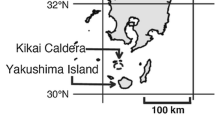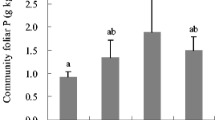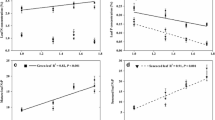Abstract
The aim of this study was to examine how shifts in soil nutrient availability along a soil chronosequence affected temperate rainforest vegetation. Soil nutrient availability, woody plant diversity, composition and structure, and woody species leaf and litter nutrient concentrations were quantified along the sequence through ecosystem progression and retrogression. In this super-wet, high leaching environment, the chronosequence exhibited rapid soil development and decline within 120,000 years. There were strong gradients of soil pH, N, P and C, and these had a profound effect on vegetation. N:Pleaf increased along the chronosequence as vegetation shifted from being N- to P- limited. However, high N:Pleaf ratios, which indicate P-limitation, were obtained on soils with both high and low soil P availability. This was because the high N-inputs from an N-fixing shrub caused vegetation to be P-limited in spite of high soil P availability. Woody species nutrient resorption increased with site age, as availability of N and P declined. Soil P declined 8-fold along the sequence and P resorption proficiency decreased from 0.07 to 0.01%, correspondingly. N resorption proficiency decreased from 1.54 to 0.26%, corresponding to shifts in mineralisable N. Woody plant species richness, vegetation cover and tree height increased through ecosystem progression and then declined. During retrogression, the forest became shorter, more open and less diverse, and there were compositional shifts towards stress-tolerant species. Conifers (of the Podocarpaceae) were the only group to increase in richness along the sequence. Conifers maintained a lower N:Pleaf than other groups, suggesting superior acquisition of P on poor soils. In conclusion, there was evidence that P limitation and retrogressive forests developed on old soils, but N limitation on very young soils was not apparent because of inputs from an abundant N-fixing shrub.




Similar content being viewed by others
References
Aerts R, Chapin FS (2000) The mineral nutrition of wild plants revisited: a re-evaluation of processes and patterns. Adv Ecol Res 30:1–67
Allen RB (1992) RECCE An inventory method for describing New Zealand vegetation. FRI Bull 176. Forest Research, Christchurch
Almond PC (1996) Loess, soil stratigraphy and Aokautere ash on late Pleistocene surfaces in South Westland, New Zealand—interpretation and correlation with the glacial stratigraphy. Quat Int 34:163–176
Almond PC Tonkin PJ (1999) Pedogenesis by upbuilding in an extreme leaching and weathering environment, and slow loess accretion, South Westland, New Zealand. Geoderma 92:1–36
Almond PC, Moar NT, Lian OB (2001) Reinterpretation of the glacial chronology of South Westland, New Zealand. N Z J Geol Geophys 44:1–15
Baylis GTS, McNabb RFR, Morrison TM (1963) The mycorrhizal nodules of podocarps. Trans Br Mycol Soc 46:378–384
Beadle NCW (1966) Soil phosphate and its role in molding segments of the Australian flora and vegetation, with special reference to xeromorphy and sclerophylly. Ecology 47:992–1007
Becker P (2000) Competition in the regeneration niche between conifers and angiosperms: Bond’s slow seedling hypothesis. Funct Ecol 14:401–412
Bellingham PJ, Walker LR, Wardle DA (2001) Differential facilitation by a nitrogen-fixing shrub during primary succession influences relative performance of canopy tree species. J Ecol 89:861–875
Blakemore LC, Searle PL, Daly BK (1987) Methods for chemical analysis of soils. N Z Soil Bureau Sci Rep 80. DSIR, Wellington
Bond WJ (1989) The tortoise and the hare: ecology of angiosperm dominance and gymnosperm persistence. Biol J Linn Soc 36:227−249
Brady NC, Weil RR (1996) The nature and properties of soils, 12th edn. Prentice-Hall, N.J.
Brubaker LB (1981) Long-term forest dynamics. In: West DC, Shugart HH, Botkin DB (eds) Forest succession: concepts and application. Springer, Berlin Heidelberg New York, pp 95–106
Chadwick OA, Derry LA, Vitousek PM, Huebert BJ, Hedin LO (1999) Changing sources of nutrients during four million years of ecosystem development. Nature 397:491–497
Craine JM, Mack MC (1998) Nutrients in senesced leaves: comment. Ecology 79:1818–1820
Crews TE, Kitayama K, Fownes JH, Riley RH, Herbert DA, Mueller-Dombois D, Vitousek PM (1995) Changes in soil phosphorus fractions and ecosystem dynamics across a long chronosequence in Hawaii. Ecology 76:1407–1424
Eckstein RL, Karlsson PS, Weih M (1999) Leaf life span and nutrient resorption as determinants of plant nutrient conservation in temperate-arctic regions. New Phytol 143:177−189
Enright NJ, Ogden J (1995) The southern conifers—a synthesis. In: Enright NJ, Hill RS (eds) Ecology of the southern conifers. Melbourne University Press, Carlton, Victoria, pp 271–287
Escudero A, del Arco JM, Sanz IC, Ayala J (1992) Effects of leaf longevity and retranslocation efficiency on the retention time of nutrients in the leaf biomass of different woody species. Oecologia 90:80–87
Grime JP (1979) Plant strategies and vegetation processes. Wiley, Chichester
Herbert DA, Fownes JH (1999) Forest productivity and efficiency of resource use across a chronosequence of tropical montane soils. Ecosystems 2:242–254
Hessell JWD (1982) The climate and weather of Westland. N Z Met Serv Misc Publ 115:10
Jenny H (1980) The soil resource: origin and behavior. Springer, Berlin Heidelberg New York
Johnson AH, Frizano J, Vann DR (2003) Biogeochemical implications of labile phosphorus in forest soils determined by the Hedley fractionation procedure. Oecologia 135:487−499
Killingbeck KT (1996) Nutrients in senesced leaves: keys to the search for potential resorption and resorption proficiency. Ecology 77:1716–1727
Kitayama K, Muller-Dombois D (1995) Vegetation changes along gradients of long-term soil development in the Hawaiian montane rainforest zone. Vegetatio 120:1–20
Koerselman W, Meuleman AFM (1996) The vegetation N:P ratio: a new tool to detect the nature of nutrient limitation. J Appl Ecol 33:1441–1450
Leathwick JR (2001) New Zealand’s potential forest pattern as predicted from current species-environment relationships. N Z J Bot 39:447−464
Leathwick JR, Morgan F, Wilson G, Rutledge D, McLeod M, Johnston K (2003) Land environments of New Zealand: technical guide. Maanaki Whenua, New Zealand
Matzek V, Vitousek P (2003) Nitrogen fixation in bryophytes, lichens, and decaying wood along a soil-age gradient in Hawaiian montane rain forest. Biotropica 35:12−19
McLaren RG, Cameron KC (1996) Soil science: sustainable production and environmental protection. Oxford University Press, Auckland
Meurk CD, Foggo MN, Thomson BM, Bathhurst ETJ, Crompton MB (1994) Ion-rich precipitation and vegetation pattern on subantarctic Campbell Island. Arct Alp Res 26:281−289
Miller RB (1961) The chemical composition of rainwater at Taita, New Zealand, 1956−1958. N Z J Sci 4:844−853
Moar NT, Suggate RP (1996) Vegetation history from the Kaihinu (last) interglacial to the present, West Coast, South Island, New Zealand. Quat Sci Rev 15:521−547
Monk CD (1966) An ecological significance of evergreenness. Ecology 504−505
Northup RR, Dahlgren RA, Yu Z (1995) Intraspecific variation of conifer phenolic concentration on a marine terrace soil acidity gradient; a new interpretation. Plant Soil 171:255−262
Palmer MW (1993) Putting things in even better order: the advantages of CCA. Ecology 74:2215–2230
Peet R (1992) Community structure and ecosystem function. In: Glenn-Lewin DC, Peet RK, Veblen TT (eds) Plant succession: theory and prediction. Chapman and Hall, London, pp 103–151
Pickett STA (1989) Space-for-time substitution as an alternative to long-term studies. In: Likens GE (ed) Long-term studies in ecology. Springer, Berlin Heidelberg New York, pp110–135
Russell AJ, Bidartonda M, Butterfield BG (2002) Mycorrhizal nodules in Podocarpaceae: ultrastructure and molecular identification of fungi. New Phytol 156:283−295
Saggar S, Parfitt RL, Salt GJ, Skinner MF (1998) Carbon and phosphorus transformations during decomposition of pine forest floor with different phosphorus status. Biol Fertil Soil 27:197−204
Smith SM, Lee WG (1984) Vegetation and soil development on a Holocene river terrace sequence, Arawata Valley, South Westland, New Zealand. N Z J Sci 27:187−196
Stevens PR (1968) A chronosequence of soils near the Franz Josef glacier. PhD thesis, University of Canterbury, New Zealand
Stevens PR, Walker TW (1970) The chronosequence concept and soil formation. Q Rev Biol 45:333–350
Ter Braak CJF, Šmilauer P (1998) Canoco reference manual and user’s guide to Canoco for Windows. Microcomputer Power, Ithaca
Tessier JT, Raynal DJ (2003) Use of nitrogen to phosphorus ratios in plant tissue as an indicator of nutrient limitation and nitrogen saturation. J Appl Ecol 40:523−534
Thompson CH (1981) Podzol chronosequences on coastal dunes of eastern Australia. Nature 291:59–61
Thompson CH (1992) Genesis of podzols on coastal dunes in southern Queensland. I. Field relationships and profile morphology. Aust J Soil Res 30:593−613
Van Heerwaarden LM, Toet S, Aerts R (2003) Current measures of nutrient resorption efficiency leaf to a substantial underestimation of real resorption efficiency: facts and solutions. Oikos 101:664−669
Verhoeven W, Herrmann R, Eiden R, Klemm O (1987) A comparison of the chemical composition of fog and rainwater collected in the Fichtlgebirge, FRG, and from the South Island of New Zealand. Theor Appl Klimatol 38:210−221
Vitousek PM, Farrington H (1997) Nutrient limitation and soil development: experimental test of a biogeochemical theory. Biogeochemistry 37:63−75
Vitousek PM, Turner DR, Kitayama K (1998) Foliar nutrients during long-term soil development in Hawaiian montane rainforest. Ecology 76:712−720
Walker LR, del Moral R (2003) Primary succession and ecosystem rehabilitation. Cambridge University Press, Cambridge.
Walker TW, Syers JK (1976) The fate of phosphorus during pedogenesis. Geoderma 15:1–19
Walker J, Thompson CH, Fergus IF, Tunstall BR (1981) Plant succession and soil development in coastal sand dunes of subtropical eastern Australia. In: West DC, Shugart HH, Botkin DB (eds) Forest succession: concepts and application. Springer, Berlin Heidelberg New York, pp 107–131
Wardle DA (2002) Communities and ecosystems: linking the aboveground and belowground components. Princeton University Press, Princeton
Wardle P (1977) Plant communities of Westland National Park (New Zealand) and neighbouring lowland and coastal areas. N Z J Bot 15:323–398
Wardle P (1980) Primary succession in Westland National Park and its vicinity, New Zealand. N Z J Bot 18:221–232
Wardle P (1991) Vegetation of New Zealand. Cambridge University Press, Cambridge
Wardle DA, Ghani A (1995) A critique of the microbial metabolic quotient (qCO2) as a bioindicator of disturbance and ecosystem development. Soil Biol Biochem 27:1601–1610
Watson DM (2002) A conceptual framework for studying species composition in fragments, islands and other patchy ecosystems. J Biogeogr 29:823−234
Westman WE (1975) Edaphic climax pattern of the pygmy forest region of California. Ecol Monogr 45:109–135
Wright IJ, Westoby M (2003) Nutrient concentration, resorption and lifespan: leaf traits of Australian sclerophyll species. Funct Ecol 17:10–19
Wright IJ, Reich PB, Westoby M (2002) Convergence towards higher leaf mass per area has different consequences for leaf lifespan in dry and nutrient-poor habitats. J Ecol 90:534−543
Acknowledgements
P. Almond shared his invaluable knowledge of the area and enabled us to incorporate later sites into the sequence. We thank D. Wardle for help with site selection, S. Wiser for suggestions about ordination techniques, J. Barringer for providing precipitation data, B. Daly for laboratory analyses, P. Clinton for information about shotgun sampling techniques, and P. Bellingham, F. Carswell, K. Orwin, D. Wardle, W. Williamson and J. Wilmshurst for comments and advice. M. Brignall-Theyer, J. Bee, J. Cruickshank and L. Nicholls provided excellent assistance in the field and laboratory. The project was funded by the Royal Society of New Zealand Marsden Fund and Landcare Research’s investment of retained earnings.
Author information
Authors and Affiliations
Corresponding author
Electronic Supplementary Material
Rights and permissions
About this article
Cite this article
Richardson, S.J., Peltzer, D.A., Allen, R.B. et al. Rapid development of phosphorus limitation in temperate rainforest along the Franz Josef soil chronosequence. Oecologia 139, 267–276 (2004). https://doi.org/10.1007/s00442-004-1501-y
Received:
Accepted:
Published:
Issue Date:
DOI: https://doi.org/10.1007/s00442-004-1501-y




